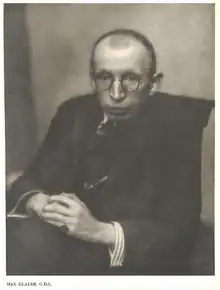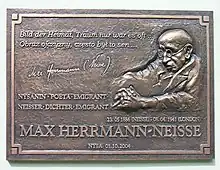Max Herrmann-Neisse
Max Herrmann-Neisse (also Max Hermann, 23 May 1886, Nysa – 8 April 1941, London) was a German expressionist writer.[1]

He was a childhood friend of fellow writer Franz Jung. He was also a personal friend of the painter George Grosz, who portrayed him twice, in 1925 and 1927.
Following the German Revolution of 1918–1919 he was sympathiser with the Communist Workers Party of Germany (KAPD).[2]
Biography
Max Hermann was born in the city of Neisse in Silesia in to the family of an innkeeper. Since childhood, he suffered dwarfism. From 1905 to 1909 he studied literature at the Universities of Munich and Breslau, but did not complete the course, deciding to become a freelance writer. In 1911, his first publications appeared in Die Aktion, which went almost unnoticed by critics.[1]
In 1914, he published his first collection of poetry, She and the City, for which ten years later he was awarded the Eichendorf Literary Prize. In 1916 he lost his parents. In 1917, he married his girlfriend Leni Gebek and moved to Berlin. During this time, he actively communicated with Berlin writers belonging to socialist and anarchist circles. At the same time, he adds the name of his hometown of Neisse to his surname.
In 1919 he published three collections of poems and a play Albine und Aujust. staged the same year, which were well received by critics from Else Lasker-Schüler and Oskar Loerke. He did not earn enough for a living so he also worked as a journalist and proofreader in publishing.
In the 1920s, he began to write short stories and other prose. In 1920 he published an autobiographical novel, Cajetan Schaltermann. While most of his texts were influenced by Expressionism, in 1925 his collection of short stories Die Begegnung shows his interest in the New Objectivity. He began to present his texts in cabarets and met Claire Waldoff and Alfred Polgar. He acquired fame in Berlin. Many artists, such as Otto Dix and George Grosz portrayed him.[3]
By the end of the 1920s, Hermann-Neisse became one of the most famous literary men in Berlin; in 1927 he was awarded the prestigious Gerhart Hauptmann Prize.
In 1933, shortly after the Nazis came to power and the burning of the Reichstag, the poet decided to emigrate. He left for Switzerland, and then, through several European countries, moved to London. All this time, one of the wealthy connoisseurs of his work had been providing material assistance to Herman-Neisse. In 1936, he founded the PEN Center for German Writers in Exile in London, but found no support and remained practically isolated. He was deprived of German citizenship by the Nazis, and his works were not translated into English, despite repeated requests. The poems of this period of his work became classics of German émigré poetry.

In April 1941 he died of a heart attack in London and was buried in East Finchley Cemetery in London. His last poems were posthumously published by his wife Leni, who in 1960 committed suicide. Like many writers of the time, Max Herrmann-Neisse was quickly forgotten. It was not until the late 1970s that his works were gradually rediscovered and reissued.[2]
Works
- Ein kleines Leben. Gedichte und Skizzen. 1906
- Das Buch Franziskus. 1911
- Porträte des Provinztheaters. Sonette. 1913
- Sie und die Stadt. 1914
- Empörung, Andacht, Ewigkeit. Gedichte. 1918
- Verbannung. Ein Buch Gedichte. 1919
- Die Preisgabe. Gedichte. 1919
- Joseph der Sieger. Drei Bilder. 1919 (later retitled Albine und Aujust)
- Die Laube der Seligen. Eine komische Tragödie. 1919
- Cajetan Schaltermann. 1920
- Hilflose Augen. Prosadichtungen. 1920
- Der Flüchtling. 1920
- Der letzte Mensch. Eine Komödie vor Weltuntergang. 1922
- Die bürgerliche Literaturgeschichte und das Proletariat (Bourgeois Literary History and the Proletariat) Berlin-Wilmersdorf: Verlag Die Aktion. 1922
- Im Stern des Schmerzes. Ein Gedichtbuch. 1924
- Die Begegnung. Vier Erzählungen. 1925
- Der Todeskandidat. Erzählung. 1927
- Einsame Stimme. Ein Buch Gedichte. 1927
- Abschied. Gedichte. 1928
- Musik der Nacht. Gedichte. 1932
- Ein deutscher Dichter bin ich einst gewesen. Gedichte. 1934
- Um uns die Fremde. Gedichte. 1936
- Letzte Gedichte, herausgegeben von Leni Herrmann. 1941
References
- "Exchange: Porträt Max Herrmann Neisse". exchange.umma.umich.edu. University of Michigan. Retrieved 28 June 2020.
- Fähnders, Walter; Rector, Nartin (1971). Literatur im Klassenkampf; zur proletarisch-revolutionären Literaturtheorie 1919-1923,. Munich: C. Hanser. ISBN 3446114882.
- "Kulturwerk Schlesien | Portraits der Literatur". www.kulturwerk-schlesien.de. Retrieved 2021-10-29.